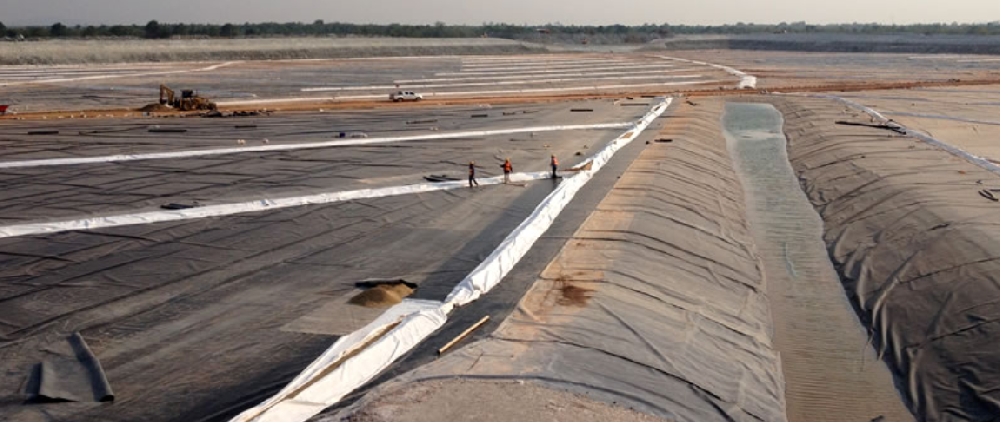- Understanding the Role of Geomembrane Liners in Waste Management
- Innovations in Geomembrane Liners for Water Management
- Geomembrane Liners: A Comprehensive Guide
- The Future of Geomembrane Liners in Civil Engineering
- Geomembrane Liners: Enhancing Landfill Stability
Manager:Alvin Wang
WhatsApp:+62 8983806051
Tel:+86 10-5797-1075
Email:steelwang@okorder.com
Address:3rd Floor, No.2 Building, No.1 Sanlihe Road
Is HDPE geomembrane the same as PEX?
The two plastic materials, High-Density Polyethylene (HDPE) geomembranes and Cross-Linked Polyethylene (PEX), have different characteristics as well as applications. However, they are not the same items of substances because their application in engineering and construction differs. This essay will therefore highlight the dissimilarities between a hdpe Geomembrane and PEX while elucidating on what each of them is used for.

1 Introduction to HDPE Geomembrane and PEX
HDPE geomembranes are artificial sheets made from high-density polyethylene resin- a thermoplastic polymer with excellent toughness, durability and chemical resistance. They find many uses in engineering and environmental practices as containment measures, protective covers or barrier facilities. One major use of these sheets is lining landfills while others are pond liners, reservoirs, hazardous waste containment facilities among others.
On the other hand, PEX is a kind of plastic tube produced from cross-linked polyethylene resin. It can bend without breaking down easily; it does not rust; it can be fixed easily when damaged. Therefore, in plumbing it is prevalent due to Its flexibility especially when used to carry hot or cold water as well as for radiant floor heating systems among other uses. These pipes come in different sizes including various colors depending on various plumbing requirements.
2 Material Composition and Structure
The major distinction between HDPE geomembrane and PEX concerns their composition/structure of both materials. In particular, HDPE geomembranes consist of high density polyethylene resin which is extruded into continuous sheets with varying thicknesses. Usually these geosynthetics are composed of several layers that have been melted together under intense heat and pressure so that there result a strong impenetrable membrane.
On the other side PEX tubing consists of cross linked polyethylene resins formed through a process known as cross linking. This is done by joining polymer chains in the polyethylene resin to increase its strength, flexibility and resistance to heat and chemicals. There are two ways of PXB making that is peroxide method or silane method each having slightly differing properties.
3 Applications and Uses
HDPE geomembrane and PEX tubing perform different roles and are used for different reasons due to their individual qualities and characteristics. In environmental engineering, HDPE geomembranes act as a barrier between certain fluids, such as gases or liquids. They are often used as landfill liners, pond liners, reservoirs, hazardous waste containment facilities.
By contrast PEX tubes are mainly applied in plumbing systems for transporting water at high temperatures. Among other things PEX is flexible enough not to crack; it does not corrode, hence it can be easily installed for commercial buildings' water supplies. These pipes also serve radiant floor heating purposes whereby space temperature control is regulated.
4 Physical Properties
These two materials differ in physical properties that make them well suited for their respective applications. HDPE geomembranes are known for their strength, durability as well as chemical resistance which makes them perfect choice for containment and environmental protection purposes. Impermeable barriers against fluids and gases; imperviousness to punctures and tears; ability to withstand harsh weather conditions – all these features belong to one specific type of geosynthetic lining material called high-density polyethylene (HDPE).
The peculiar characteristic of PEX tubing is its flexibility. It can therefore be bent and stretched without the danger of kinking or breaking, making it easy to circumvent obstacles and pass through narrow paths. The PEX tube also resists scaling and corrosion from water contaminants, which means they will retain their performance over time.
5 Cost Considerations
When looking at HDPE geomembrane versus PEX tubing costs it is important to consider cost as one more factor. Usually, HDPE geomembranes are thicker and require special manufacturing processes that make them more expensive per foot basis than PEX tubing. However, the overall cost of a geomembrane system or plumbing system will depend on factors such as material thickness, installation complexity and project specific requirements.
Thus while initial cost may be higher for HDPE a long term cost saving is expected due to its durability and low maintenance requirement. In fact HDPE has longer life span compared to PEX tubing hence less prone to damage resulting in high expenses on repairing or replacing.

6 Conclusion
In summary, two types of plastic materials exist; namely, HDPE geomembrane and PEX tubing with distinct properties, characteristics and applications. These mostly serve as impermeable barriers in engineering works or environmental application involving transport of fluids, gases or contamination respectively. On the other hand, pex piping is primarily used for cold hot water plumbing connections or radiant floor heating systems in homes.
While both HDPE geomembrane and PEX tubing are composed of polyethylene resin these materials are designed differently based on their end uses where they have different physical properties. Through understanding the differences between HDPE geomembrane versus Pex Tube engineers plus project managers may confidently select suitable material for their projects accordingly.
- Previous:What are the disadvantages of HDPE geomembrane?
- Next:Why is HDPE geomembrane better than PVC?
-
2024-12-05Geomembrane Liners: A Comprehensive Guide






